The “Brux” is for Bruxelles where the chaudronnerie Peter made beautiful copper.
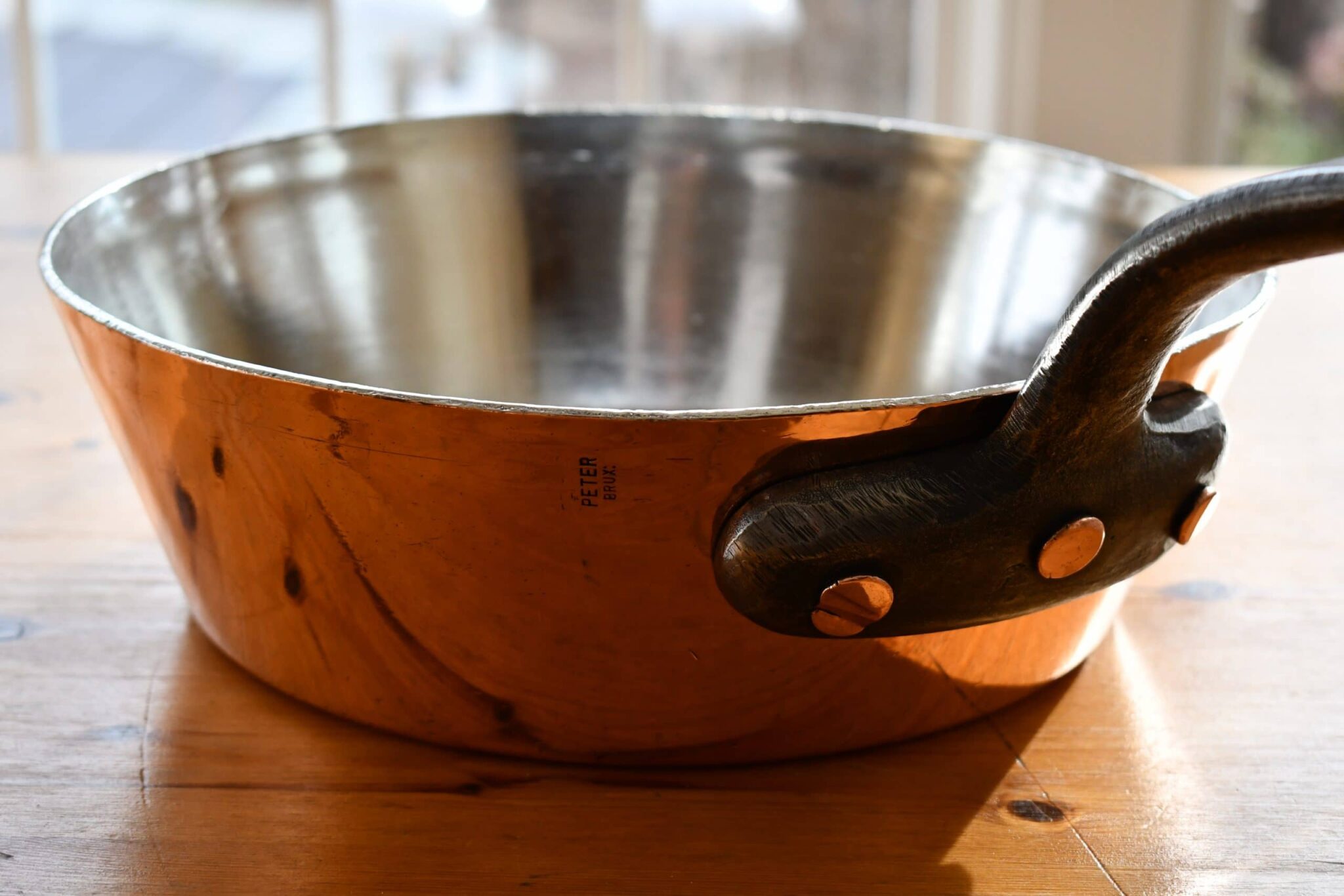
- Type: Tin-lined Windsor in smooth finish with a cast-iron handle fastened with three copper rivets
- French description: Sauteuse évasée étamée et martelée avec queue de fer munie de trois rivets en cuivre
- Dimensions: 30cm diameter by 9.5cm tall (11.8 by 3.7 inches)
- Thickness: 3.2mm at rim
- Weight: 4632g (10.2 lbs)
- Stampings: “PETER BRUX.”
- Maker and age estimate: Peter; post-1950?
- Source: Private sale
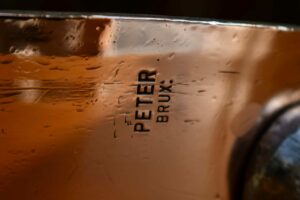 While the French may have been the most well-known chaudronniers from the 18th century to the present, they have never been the only ones making high-quality copper cookware. The chaudronnier Peter began making copper cookware and other kitchenware items in 1933 in Brussels, Belgium. According to TJFRANCE, Peter did not start stamping their copper until after 1945; their first stamp design included their rue de la Fontaine address, but later pieces were stamped simply “Peter” and “Bruxelles” or “Brux.” That suggests that this pan of mine was likely made during the 1950s or later.
While the French may have been the most well-known chaudronniers from the 18th century to the present, they have never been the only ones making high-quality copper cookware. The chaudronnier Peter began making copper cookware and other kitchenware items in 1933 in Brussels, Belgium. According to TJFRANCE, Peter did not start stamping their copper until after 1945; their first stamp design included their rue de la Fontaine address, but later pieces were stamped simply “Peter” and “Bruxelles” or “Brux.” That suggests that this pan of mine was likely made during the 1950s or later.
This is a sauteuse évasée, “flared saucepan,” also called a Windsor. It is proportioned like a sauté pan: 30cm (11.8 inches) wide at the rim and 9.5cm (3.7 inches) tall, just a hair taller than one of my 30cm sautés. Its flared shape creates increased surface area to help with reduction and its sloped sides leave no deep corners to trap sauce. I sometimes see this style of pan called a fait-tout (“does it all”) because it can both sauté as well as simmer.

There is a faint impression running around the rim, visible in the photo below, about a centimeter below the top edge. Reader Roger suggests that this mark could have come about if the pan was slightly too large for its mandrel when it was spun, creating a slight deformity at the edge of the mandrel. I think that’s a very good possibility given this pan’s large diameter — thank you, Roger, for pointing this out!

The cast-iron handle has an interesting roughness to it. These score marks are from filing or grinding the handle after it was cast to remove hard edges. This is my only Peter piece but I am wondering if this finishing could be a characteristic of this marque.
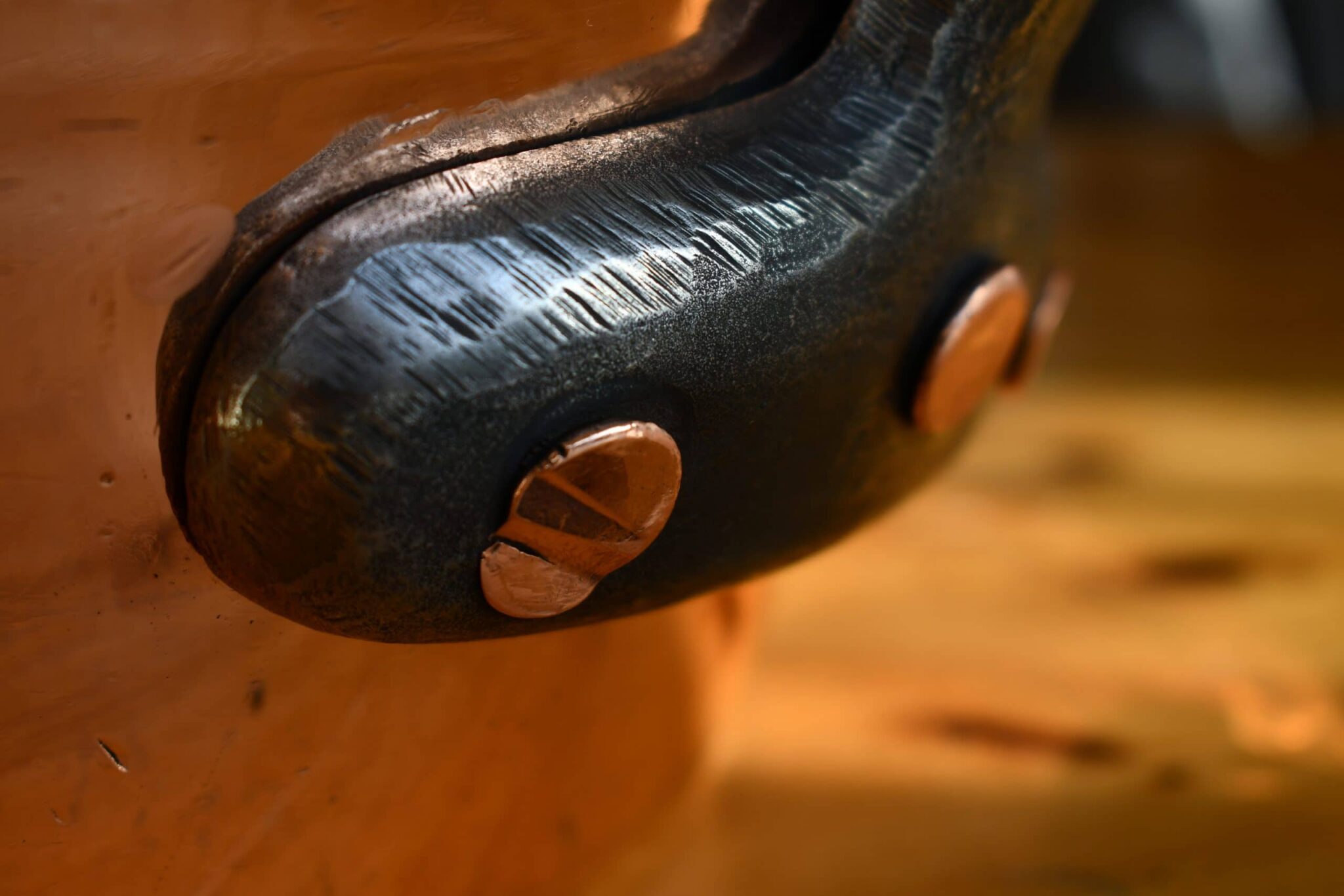
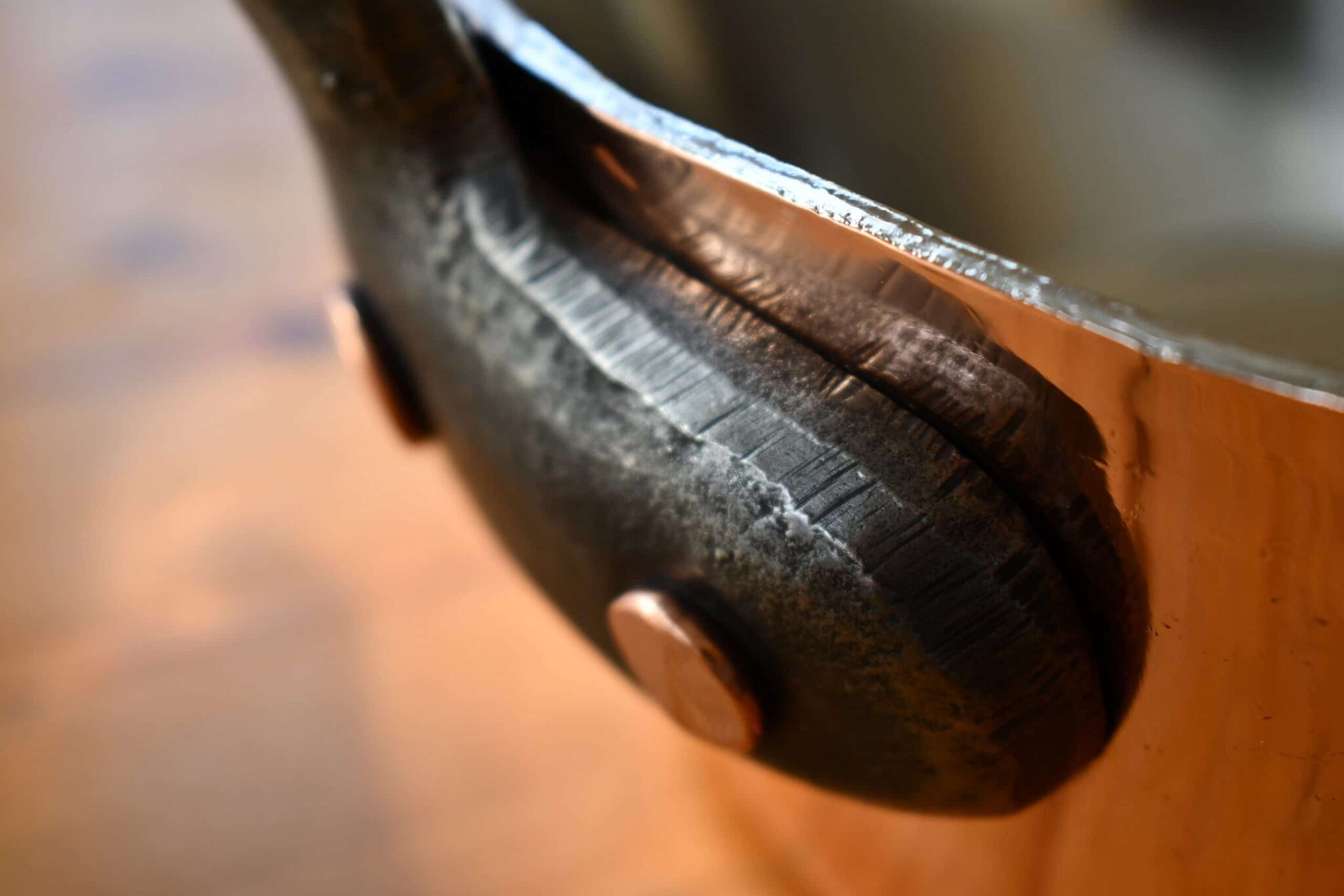

The rivets are rough and large. The outer surfaces are faceted from hammer strikes and the left-side rivet is deformed; the interior rivet heads are flat and set flush to the surface.

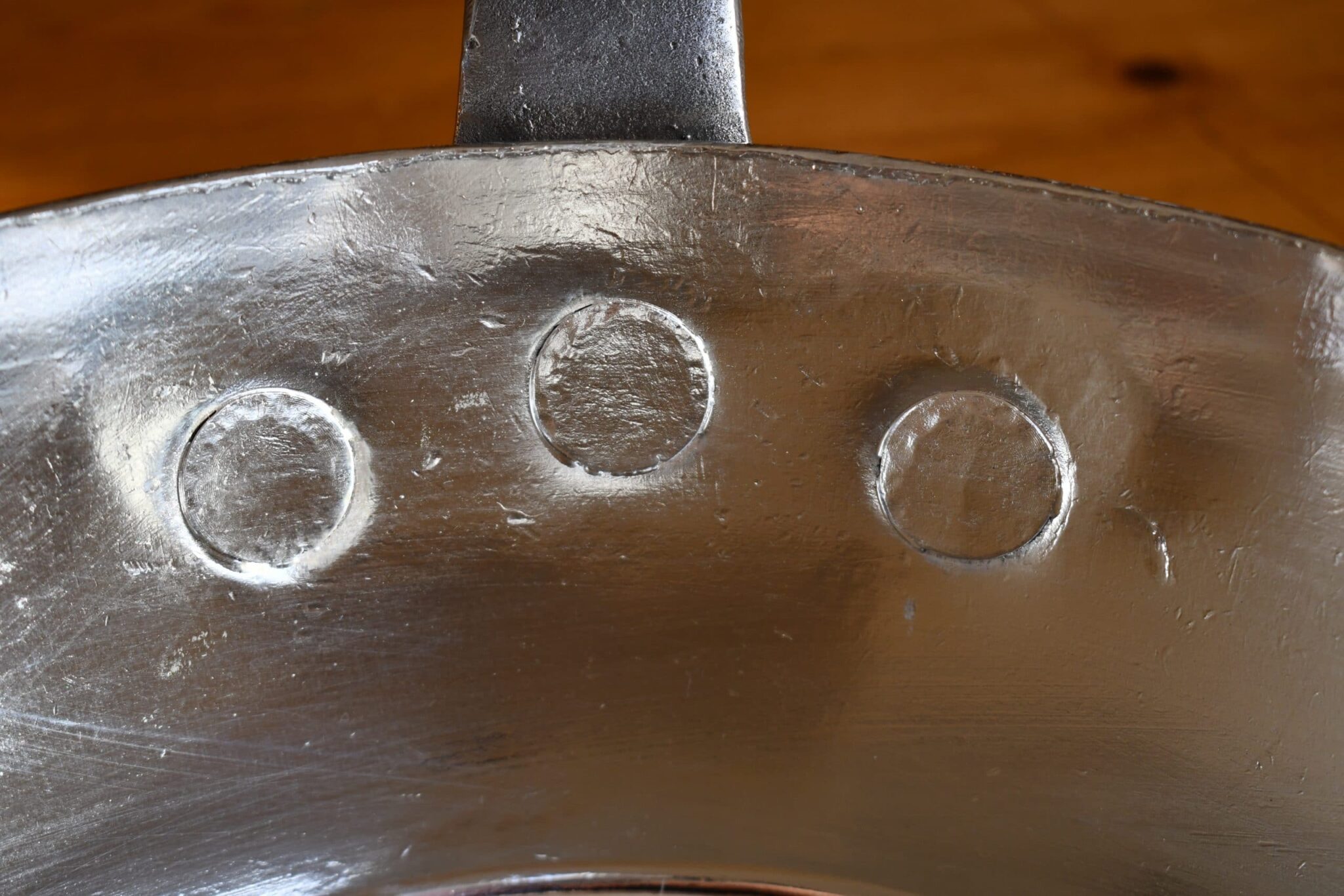
Compare this look to the small round rivets of post-war French work. Based on its “Peter Brux” stamp and TJFRANCE’s information, this could be a 1950’s pan; I’d expect to see machined rivets in a pan of this era, benefiting from the widespread industrialization of World War II. Mauviel pieces that Williams-Sonoma was beginning to import to the United States in the early 1960s have small round neat rivets with domed interior heads, but the rivets on this Windsor look more like late 19th or early 20th century work, when rivets were custom-made and hand-hammered. This suggests to me that Peter was not using the same machinery as the French makers in Villedieu or Paris but instead continued to hand-rivet pans for a period after WWII.
There are alternative possibilities of course: this could be a pan made in the 1930s that was not stamped and sold until the 1940s or later. Or it could also be that a hefty pot like this — ten pounds unladen — needed beefier rivets than Peter’s riveting machine could handle at the time, and so it was hand-riveted. Whatever the explanation, the rivets look to me like an interesting anachronism on a post-war pan.
I’m still researching Peter and I’d welcome any information you have about it. Peter was a kitchenware store as well as a chaudronnerie, and according to TJ they stopped making their own copper after a while and resold French pans. I don’t know when this transition occurred but it would be quite useful to know.
I love this piece. My thanks to the private seller who kept it in wonderful condition and also to Erik Undiks at Rocky Mountain Retinning for a beautiful tinning job.
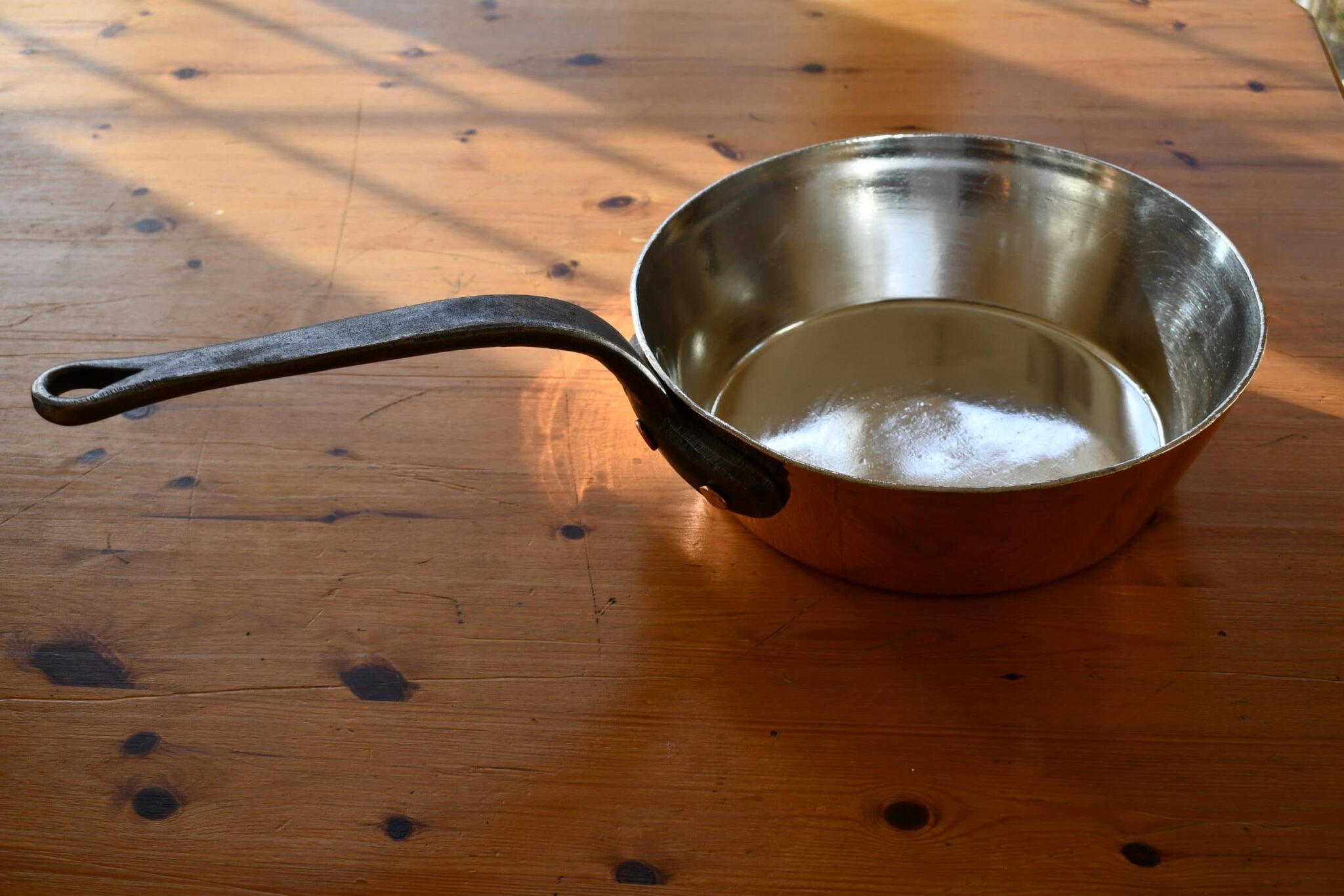
Update: Here’s a super close-up of the stamp on this pan. You can see that the mark after “Brux” is a period, with a flaw in the stamp that looks like the upper pip of a colon but is not. I see this same stamp with this same flaw on other pieces and it’s useful to be able to tie them together!







Hi,
Peter Brux were the first two copper pans I bought. 18 x 12 1/2 and 22 x 13 1/2 cm, and both approximately 2.5 mm thick. The smaller has the same stamp as yours and the larger a bigger version with a (.) instead of a (:) reading downward. Neither showed any signs of use so I assume toward the end of production. There are feint ridges consistent with spinning and no hammering. The handles are rough cast like yours with grinding marks. The smaller one has “1” cast just below the hanging loop which is unfinished and sharp inside. Rivets have concentric circles inside and machine formed cheeseheads outside.
Handles are straight and leave the pan at a steep angle so balance is not very good and as a consequence I don’t use the larger one though I am thinking of adding a helper handle.
Hey Roger! Do you think the crease mark on mine is from spinning rather than pressing as I had thought?
Also, I’m undecided about whether the stamp on mine is BRUX. (with a period) or BRUX: (with a colon). Looking closely at mine, I thought it was BRUX. (period) with a happenstance small mark that looks like the upper pip of a colon but that isn’t part of the stamp. To my eye, this mark is slightly out of alignment and not quite a round pip, so I assumed it couldn’t be part of a colon symbol (let alone the grammatical incorrectness of a colon in this context). And yet I hear of other examples like yours that people describe confidently as having a colon. May I ask you to look closely at your “colon” version? Is it a true two-pip colon mark, or does it have the same “happenstance” mark as mine?
Hi,
it is a colon on the smaller stamp where PETER measures 13mm across and a full stop on the larger 19mm stamp, grammar/punctuation rules vary with language so may account for this? Yours is the only one I have seen which reads from the base towards the rim, but I don’t remember another Windsor.
I think the crease is a result of the copper disc not being pressed fully against the former/mandrel either to achieve an increased flare or maybe the mandrel was too short so the top edge was done free-hand. All I know on this comes from online videos so I could well be wrong!
Thank you, Roger! TJFRANCE says that there are a bunch of variants of the Peter stamp out there but I’ve had trouble getting actual images of them. Yours is the first I’ve heard of with a true colon. Would you consider sharing some photos of your pots and their stamps with me? I’m working on a field guide to Peter and it’s a challenge to try to correlate stamps and approximate ages when there are few examples out there. My email is vfc at vintagefrenchcopper dot com.
I will do that but finding it difficult to get decent pictures under electric lights (hats off to you for great photography) . I think my : mark has the same slight misalignment as yours and as the large mark doesn’t have the upper dot and is likely of the same age I’m beginning to think it may be a flaw it the punch/stamp he was using.
My email account will not accept your address as valid, am I missing something?
Hi Roger — I’ll try sending you an email to see if you can reply to it. Thank you!
Hi all — I took a super closeup of the stamp on this pan and I’m pretty confident there’s a flaw in the stamp as Roger suggested that makes the period look like a colon. I added the photo to the post — take a look and let me know what you think.